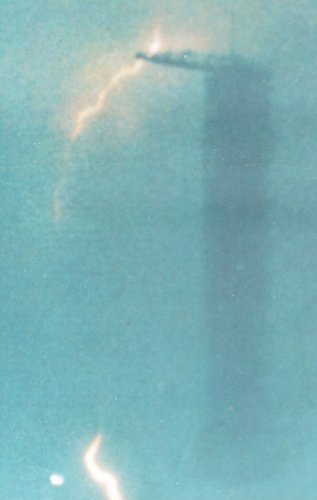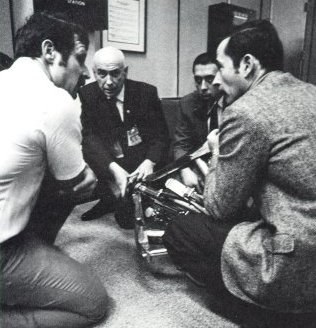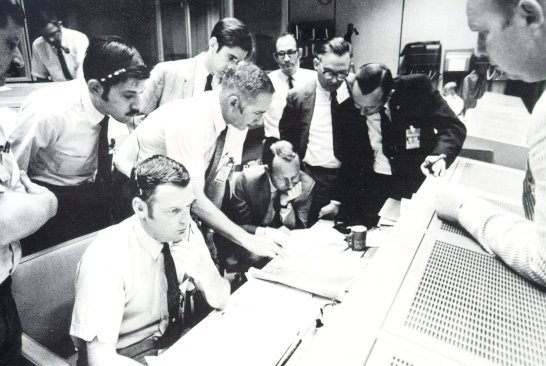Apollo Expeditions to the Moon
A LIGHTNING STRIKE

|
The lightning bolt that struck Apollo 12 aloft also
hit the crane an platform of the mobile launcher.
|
I could recall any one of hundreds of incidents that have occurred over the years
as we flew Apollo. Launch has always been an uneasy time for me, and I always
looked forward to successful separation from the booster. When one adds to this an
apprehension caused by bad weather over the Cape, I become even more concerned.
It turned out that all of the elements were present for Apollo 12. The launch was
made into a threatening gray sky with ominous cumulus clouds. Pete Conrad's words
43 seconds after liftoff, electrified everyone in the Control Center: "We had a whole
bunch of buses drop out", followed by "Where are we going?" and "I just lost the
platform." The spacecraft had been struck by lightning. Warning lights were illuminated,
and the spacecraft guidance system lost its attitude reference.
| | |
During the Apollo 13 crisis the Mission
Control directors discussed possible landing
recovery options. Because of the
unique configuration (the LM still attached
to the CM) new procedures leading to reentry
were developed. Ten phone lines
were open between Mission Control and
experts at the Grumman plant. Engineers
in Downey, Calif., where Odyssey was
built, ran emergency problems through
Computers and at MIT a team worked
through the night on the guidance system
and prepared new trajectories. Perseverance
and ingenuity were rewarded with a
safe landing in the Pacific less than 4 miles
from the USS Iwo Jima. |

|
When the Apollo 14 crew was unable,
after repeated attempts, to dock with the
lunar module, the Operations Team was
faced with the prospect of having to abort
the mission. In order to work out new
procedures, Mission Control hastily located
a docking probe and drogue. Flight Controller
John Llewellyn (left) discusses
possible solutions with Bob Gilruth, George
Abbey, and John Young. The crew docked
successfully with the new procedure, and
had no trouble docking again.
|
The spacecraft was still climbing outbound, accelerating on its way to orbit.
There was not much time to decide what should be done. The crew was given a "go"
for staging and separation from the first stage of the Saturn V launch vehicle, Within
seconds, John Aaron, the CSM electrical and environmental systems engineer, found
what had happened. Pete was asked to switch to the secondary data system so that
telemetry would show the status of the electrical system. The crew was then asked
to reset the fuel cells, which came back on line, and Apollo 12 continued on its way
into orbit. Additional checks were made of the spacecraft electrical system and a
guidance reference was reestablished. Apollo 12 went on to the Moon.
A chapter of this book is devoted to Apollo 13. As I moved up in the organization,
I reluctantly relinquished the job of flight director. But there were many well
qualified young men to assume this responsibility. My faith in their abilities was
confirmed by their actions during this epic flight. Following the successful return of
the Apollo 13 crew, the performance of the Operations Team was recognized with the
presentation of the Medal of Freedom by the President of the United States to Sig
Sjoberg, my colleague through all the tribulations of Mercury, Gemini, and Apollo.
Docking was another major hurdle that had to be overcome if we were to make
it to the Moon. Normally, it went well but I always breathed easier when it was
behind us. There had been no major docking problems in the program until Apollo 14.
After five unsuccessful attempts by Al Shepard and his crew, we still had not made
the initial docking with the lunar module. Previously we'd always had a docking
probe and drogue available in the Control Center, as well as experts on the system,
but now there were frantic calls for assistance and the absent docking system had to
be hurriedly located to help understand what might be going on thousands of miles
out in space. Procedures were worked out and another attempt proved successful.
|



